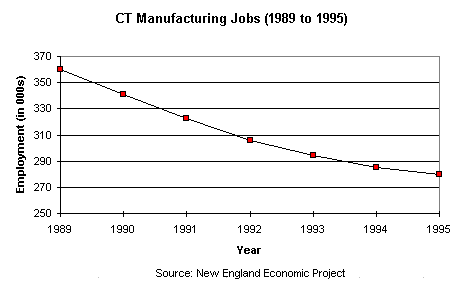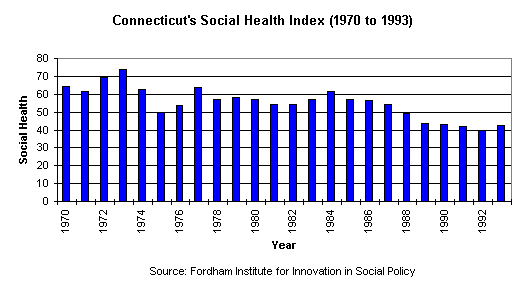![]()
Employment
Connecticut entered into recession in early 1989 after a period of remarkable economic growth. The state's recession officially ended in the fourth quarter of 1992, but its impact has lingered and can still be felt in certain sectors of the economy.
The recession cost the state approximately 162,000 jobs on a seasonally adjusted quarterly basis. By the second quarter of 1995, Connecticut managed to recover only about 14% of the recession- based job losses. Throughout 1995, the state experienced little sustained job growth. The employment pattern has been mixed -- a month of job gains followed by a month of job losses. Projected cuts in defense, banking, insurance and general manufacturing are expected to leave 1995 net employment close to its 1994 level.

Job losses have been especially severe in the state's manufacturing sector. Over 40% of the total recession-based job losses came from this one employment sector. While total seasonally adjusted nonfarm employment in the state is up from its fourth-quarter 1992 low, manufacturing employment has continued to slide. Manufacturing job losses are expected to continue until the year 2000. It is significant to note that in 1950 over 50% of the state's labor force worked in manufacturing. Today the manufacturing sector employs about 19% of the workforce.

The loss of manufacturing jobs is significant for a number of reasons. Historically, Connecticut's manufacturing sector, with its high productivity rates (higher than both New England and the U.S.), fueled much of the state's wage growth. With the decline in manufacturing employment, Connecticut has also seen a decline in average weekly wage growth. In FY 1994-95, wage growth in the state was less than 1% -- a relatively dismal performance.
While total nonfarm employment remains stagnant in the state, new jobs are being created in various fields. The service sector has experienced sustained job growth, now employing approximately 30% of the total state workforce. Much of the job growth comes from small businesses. Between 1982 and 1992 firms employing fewer than 50 workers experienced a 19% rate of job growth, while the overall economy saw 12% job growth. Unfortunately, this sector- specific job creation has been offset by job cuts in key industries across the state. However, it is important to recognize that Connecticut's economy is experiencing some job creation.
| EMPLOYMENT IN CONNECTICUT | |||
| Employment Measure | 1st Quarter 1989 | 4th Quarter 1992 | 2nd Quarter 1995 |
|---|---|---|---|
| Total Nonfarm | 1,684,100 | 1,522,100 | 1,543,800 |
| Total Manufacturing | 367,100 | 300,100 | 281,600 |
| Unemployment Rate | 3.2% | 6.9% | 5.1% |
At 5.1%, Connecticut's unemployment rate is relatively low. This statistic is somewhat deceptive because it does not account for people who have been forced out of the state's labor market. It also does not account for individuals who are underemployed (individuals who have been forced to accept part-time employment, or employment outside of their area of training). For these reasons, this report does not include comparative unemployment rates. Rather, it focuses on job creation statistics, which provide a truer measure of economic health.
Other Economic Indicators
Housing permit activity serves as a reliable indicator of emerging demographic trends and of overall state economic activity. A comparison of the third quarter of 1994 to the third quarter of 1995 shows a 22% decline in housing permits. In 1995, a total of 2,294 permits were issued in the third quarter, compared to 2,954 in the third quarter of 1994. However, two factors may help to moderate this decline. Due to continued low interest rates for mortgages and lower prices in the housing market, 1995 may end with a total housing permit decline of about 10%.
New car registrations plunged 32% in the third quarter of 1995 from the same period in the previous year. During this time total retail sales fell 3.4%. Connecticut's retail sales were $7.28 billion in the third quarter of 1995 compared to $7.54 billion for the same quarter in 1994. By comparison, third quarter national retail sales rose by 5.6%. Connecticut's Gross State Product will show only a modest increase for 1995, about 2% above the 1994 level. Not surprisingly, the Connecticut Consumer Confidence Index hit a twelve-month low in September of 1995.
Although the overall economic picture is not good, there are positive notes. As detailed above, the state has experienced sector-specific job creation in 1995, which has kept the unemployment rate from climbing. Travel and tourism grew by 5.8 % from the 1994 pace, and hotel and motel receipts increased 6% in the third quarter of 1995 from the same period a year earlier.
Economic Projections
Every five years, the U.S. Bureau of Economic Analysis (BEA) projects state and regional economic activity. These projections are used mainly to: (1) assess future demands for goods and services, (2) analyze economic trends and anticipate future economic problems, and (3) provide baselines to assist in evaluating the effects of policies. BEA's projections rely on historic patterns of economic activity and data that resides in the Bureau's Regional Economic Information System (REIS). The projections also incorporate recent economic and demographic trends. The latest set of BEA projections provide forecasts to the year 2005.
The BEA projections do not show much economic improvement for Connecticut as we enter the next century. Connecticut's annual rate of growth in personal income between 1993 and 2005 is expected to be 1.9%, which is below the projected national average of 2.2%. Gross State Product is also expected to grow at a slower rate than the national average between 1993 and 2005, increasing at a 2% rate. In addition, BEA expects an economic slowdown to occur between the years 2000 and 2005. As one might expect from these economic projections, job growth in Connecticut is expected to be weak. Total employment in the state between 1993 and 2005 is projected to grow at an annual rate of 1.4 %, with the service sector continuing to increase its share of total state employment. However, this sector provides the smallest increase in productivity per employee over the period.
Connecticut's "Social Health"
For decades, policy analysts and government agencies have been measuring and reporting economic trends. Over the years, economic indicators (including gross domestic product, consumer price index, and the index of consumer confidence) have grown in importance and sophistication. However, the relatively narrow focus of these indices has led some to question how accurately these measures gauge how we are doing as a state or a nation. In fact, nearly every other industrialized country publishes an additional, broader kind of measure -- one that assesses changes in a society's social health.
Recently, the Fordham Institute for Innovations in Social Policy released a report entitled The Social State of Connecticut in 1995. The goal of this report was to provide an overview of the state's social performance since 1970. An "index of social health" measured such things as health, employment, income, education, security, and psychological well-being. Considered together, these indicators tell a lot about the quality of life in Connecticut.
The Fordham Institute used the following categories to assess Connecticut's social health:
| Children | Youth | Adults | All Ages |
| Infant Mortality | Youth Suicide | Unemployment | Violent Crime |
| Child Abuse | High School Completion |
Average Weekly Wages |
Housing Prices |
| Teenage Births | Health Care Costs | Income Variations |
Overall, between 1970 and 1993, Connecticut's social health declined from 65 to 43 (on a scale of 100). Since 1984, the state has experienced a 19 point deterioration in social health, falling each year except 1993, which showed a modest 3 point improvement from the previous year.

The Fordham Institute report notes that during the twenty-four years since 1970, seven of the eleven indicators grew worse, while four improved.
| Those that worsened were: | Those that improved were: | |
| Child Abuse | Infant Mortality | |
| Youth Suicide | Teenage Births | |
| High School Completion | Average Weekly Wages | |
| Unemployment | Housing Prices | |
| Health Care Costs | ||
| Violent Crime | ||
| Income Variations |
When one looks at Connecticut's social health by decade, a similar pattern emerges. The mean or average index for the 1990s is much worse than either of the two previous decades. In addition, as the chart that follows reveals, the best year, 1993, ranks below the worst years of the 1970s or 1980s.
| Decade | Mean Index | Highest Index | Lowest Index |
|---|---|---|---|
| 1970-1979 | 61.4 | 73.6 | 50.0 |
| 1980-1989 | 54.6 | 61.8 | 43.6 |
| 1990-1993 | 41.9 | 43.0 | 40.0 |
Summaries of Selected Measures
Infant Mortality
The infant mortality rate measures the number of infant deaths in the first year of life for each thousand live births. Overall, Connecticut's infant mortality rate has improved significantly. In 1970, there were 17.2 deaths for each thousand live births. By 1992, the rate had dropped to 7.6. On this measure, Connecticut ranks 16th in the nation and is below the national average of 8.5.
However, much more work needs to be done on this issue. For example, the African American infant mortality rate of 17.2 is nearly three times the 6.2 rate for Caucasians and reflects a substantial increase over the 1991 rate of 13.3. In a state with significant resources, Connecticut's low rankings, especially among the minority population, is cause for great concern. The state must address these disparities as a high priority issue.
High School Completion
A well-educated work force is one of Connecticut's traditional strengths. However, Connecticut has made little progress over the past two decades. In 1993, graduation rates were slightly worse than they were in 1970 (80% compared with 82.4%), although they have shown improvement since the early 1980s. An analysis of when students drop out of high school revealed that the majority (54%) do so in either 9th or 10th grade, showing that early intervention may be the key to improvement in this area.
Among the school districts, large urban areas such as Hartford, Bridgeport, and Waterbury showed high drop-out rates, with New Haven slightly lower. Areas with drop-out rates of less than 1% included Darien, East Haven, Greenwich, Guilford, New Canaan, South Windsor, Trumbull, Westport, and Wilton.
Average Weekly Wages
Overall, between 1970 and 1993, average weekly wages for Connecticut's factory production workers rose slightly in constant dollars. However, though manufacturing wages have risen, this sector has diminished in size over time, hiring a smaller proportion of the work force.
According to the Fordham Institute, the manufacturing sector has become a relatively small part of Connecticut's employment picture. In 1950, more than 50% of the workforce was engaged in manufacturing. That percentage decreased to 37% by 1970 and to 19% by 1993.
Housing Prices
The market for affordable housing worsened during the 1980s as prices rose sharply. Since then, the situation has improved, returning to nearly the same point it was in the early 1970s. In 1993, the median price of a single family home was $137,500, about five times the per capita personal income of the state.
Despite recent improvements, housing prices remain high compared with the region and the nation. In the early 1990s, Connecticut's housing costs were 43% above the median for the Northeast region and 125% higher than the nation's.
While the market for home buyers has improved somewhat, rental costs remain high. In 1994, the average monthly rent for a two-bedroom apartment in Connecticut was $793, which represents 111.4% of the minimum wage. On this measure Connecticut ranks second worst in the nation (behind only Hawaii) in rental costs compared to income.
Back to Report Table of Contents.
Back to Comptroller's Home Page